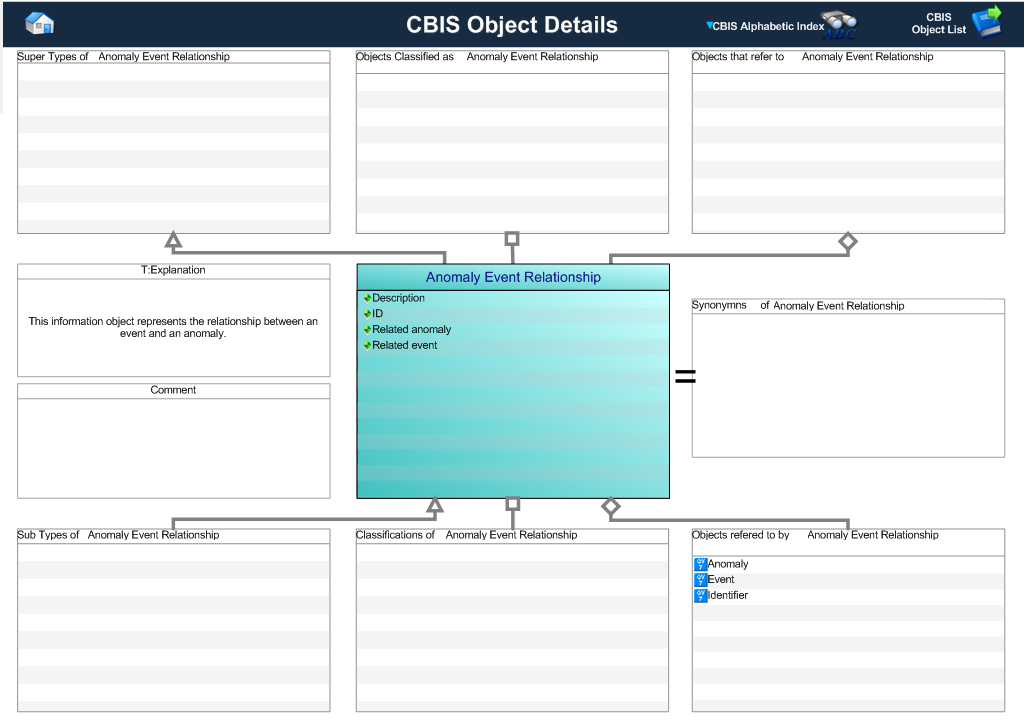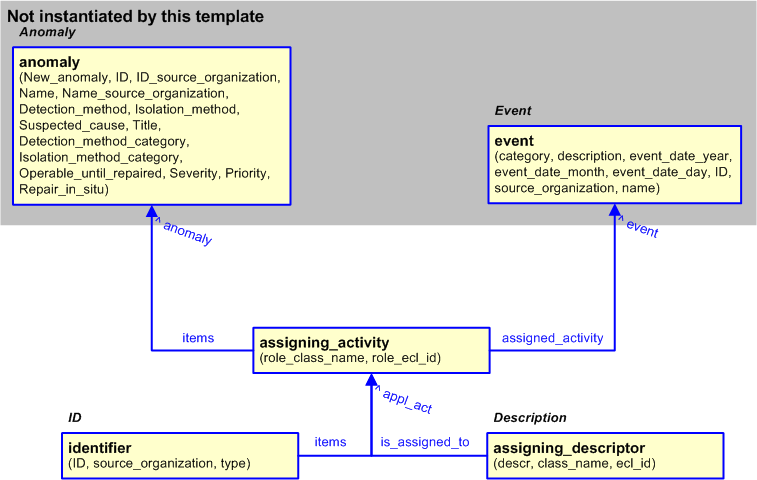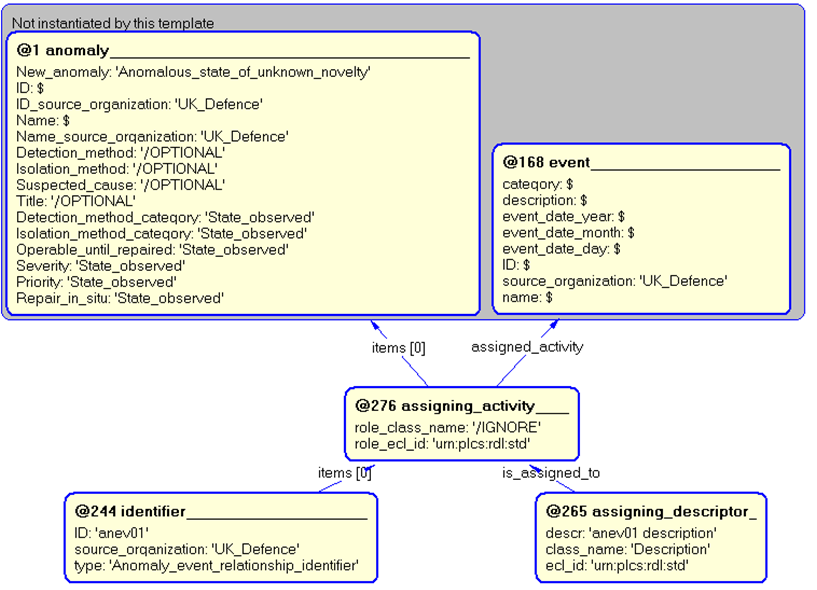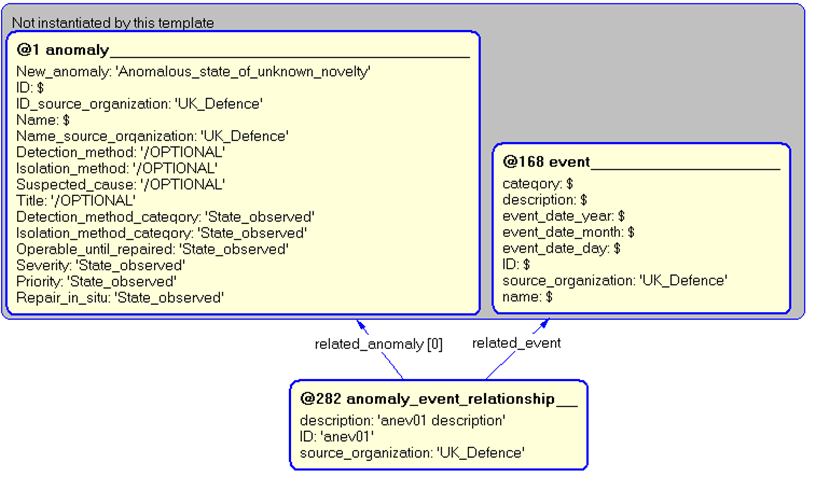Template:— anomaly_event_relationship (an_evt_rel)
Context:— UK_Defence |
Date: 2010/03/15 14:22:41
Revision: 1.2
|
This section specifies the template anomaly_event_relationship.
NOTE
The template has been defined in the context of
UK_Defence.
Refer to the business context for details of related templates.
NOTE
An explanation of a template and the associated instantiation path is
provided in the
Template overview
section.
This template describes how to represent the UK_Defence concept of an anomaly_event_relationship
in terms of PLCS model elements (templates, entities, and reference data).
This template describes how to represent UK_Defence event using
Applied_activity_assignment
This information object represents information about the relationship between an event and an anomaly.
Figure 1 — Graphical Representation for Business Object Anomaly Event Relationshp
Anomaly Event Relationship
The definition of a Anomaly Event Relationship object is:
This information object represents information about the relationship between an event and an anomaly.
|
Attribute name
|
Attribute description
|
Attribute type
|
Optionality
|
| Description |
This is the description of the anomaly event relationship. The relationship could be
that an event caused a failure (bird strike -> engine failure), or it could be that an anomaly
caused the event (engine failure -> accident).
|
Intrinsic |
Mandatory |
| ID |
This is the identifier of the anomaly event relationship. |
Identifier |
Mandatory |
| Related anomaly |
This is the reference to the anomaly that causes / is caused by the related event. |
Relationship to Anomaly. |
Mandatory |
| Related event |
This is the reference to the event that causes / is caused by the related anomaly. |
Relationship to Event. |
Mandatory |
Table 1 — Anomaly Event Relationship attribute details
The EXPRESS-G diagram in
Figure
2
shows the templates and EXPRESS entities that are required
to represent the template
"anomaly_event_relationship".
The text highlighted in blue shows the template parameters.
Figure 2 — An EXPRESS-G representation of the Information model for anomaly_event_relationship
The graphic for the template to be used in other EXPRESS-G diagrams
is shown in Figure
3
below.
Figure 3 — The graphical representation of the anomaly_event_relationship template
The following input parameters are defined for this template:
This is the description of the event.
This is the identifier of the event.
The organization that created the associated identifier. Additionally
a Person or Information System could be defined when either of these are the source; see Identifier template characterizations
The reference to the anomaly that causes / is caused by the related event.
The reference to the event that causes / is caused by the related anomaly.
The following reference parameters are defined for this template:
%^target = $anomaly_event_relationship.an_evt_rel%
The following parameter combinations specify a uniqueness constraint:
Unique constraint: Unique anomaly event relationship
The instantiation path shown below specifies the entities that are to be
instantiated by the template.
A description of templates and the syntax for the instantiation path is
provided in the
Templates Help/Information section.
-- Assigning Activity /
assigning_activity(
role_class_name='/IGNORE',
role_ecl_id='urn:plcs:rdl_std',
assigned_activity=@related_event,
items=@related_anomaly)/
%^an_evt_rel = $assigning_activity.appl_act%
-- Identifier /
identifier(
ID=@ID,
source_organization=@source_organization,
type='Anomaly_event_relationship_identifier',
items=^an_evt_rel)/
-- Description /
assigning_descriptor(
descr=@description,
class_name='Description',
ecl_id='urn:plcs:rdl:std',
is_assigned_to=^an_evt_rel)/
The instance diagram in Figure
4
shows an example of the EXPRESS entities and templates that are instantiated by the template:
/anomaly_event_relationship(description='anev01 description', ID='anev01', source_organization='UK_Defence', related_event='@168', related_anomaly='@1')/
(an illustration of the consolidated anomaly_event_relationship template is shown in
Figure
5 below.)
Figure 4 — Entities instantiated by anomaly_event_relationship template
The instance diagram in
Figure
5
shows the graphic symbol for the template that is to be
used in other instance diagrams. The example template is:
/anomaly_event_relationship(description='anev01 description', ID='anev01', source_organization='UK_Defence', related_event='@168', related_anomaly='@1')/
Figure 5 — Instantiation of anomaly_event_relationship template
Characterizations
No common characterizations of the template
anomaly_event_relationship
have been identified. However, the ISO 10303-239 EXPRESS model
may enable other assignments to the entities instantiated by the template.




